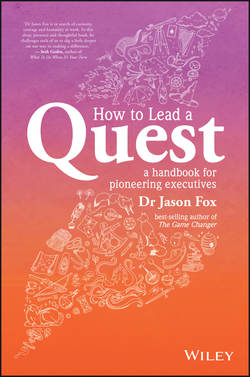Читать книгу How To Lead A Quest - Fox Jason - Страница 7
На сайте Литреса книга снята с продажи.
Part I
Default Thinking and the Kraken of Doom
1
The Anatomy of Default Thinking
ОглавлениеThe ‘default' is defined as an option that is selected automatically unless a viable alternative is specified.3 It's influenced by the sum of our experiences, and is usually the option that requires the least effort (or least angst/uncertainty/discomfort) for the most short-term gain.
‘But from whence does the default come? ' I hear you ask. Well, linguistically, ‘default' stems from the Old French word ‘defaut', which in turn stems from ‘defaillir' or ‘to fail' (from ‘fallere' – a Latin word meaning ‘disappoint' and ‘deceive').
Failure, disappointment or deception, eh? Fun. This connotation of default typically applies to not meeting a loan repayment – but there's an important message for leadership in this, too. Rely solely on default thinking, and you're going to encounter disappointment.
But, enough of that! Don't tempt me with further discussions of linguistics and semantics – I hold a doctorate in philosophy, which makes me quite inclined to engage in confusing and somewhat-irrelevant tangential pursuits of linguistic and philosophical whimsy. *sets cognac aside*
Now, in practical terms, the default comes from our ability to recognise, match and leverage patterns.
This is what Daniel Kahneman – Nobel Prize winner and author of Thinking, Fast and Slow – might describe as ‘system 1 thinking'.4 This type of thinking is fast, automatic, frequent, emotional, stereotypic and subconscious. The opposite to default thinking would be what Kahneman might describe as ‘system 2 thinking'. This type of thinking happens consciously and is, by contrast, slow, effortful, infrequent, logical and calculating.
A lot of my work involves helping leadership teams engage in more ‘slow thinking'. It's critically important, and it's how we lead and progress worthy quests. But, in my experience, the framing of a dichotomy of ‘fast versus slow' does slow thinking a disservice. Thanks to the Curse of Efficiency (see chapter 2), selling the importance of slow thinking in a world that wants fast results is … tricky.
And so, I've replaced ‘slow' with ‘thorough'. Thus, our options are to think fast, and leverage our default thinking, or we can think more thoroughly – challenging our default assumptions by exploring diverse perspectives and generating alternative options. But the detail on that comes later.
First, let's return to the anatomy of our fast, default thinking.
3
Ah, so … how do you generate viable, alternative options to consider? A splendid question! And also the main thesis of this book.
4
Of course, he would describe it in much greater depth and with more elegance than I have here. If you're unfamiliar with his work, I highly recommend you explore it.
